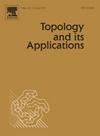Weak Baumgartner axioms and universal spaces
IF 0.5
4区 数学
Q3 MATHEMATICS
引用次数: 0
Abstract
If X is a topological space and κ is a cardinal then is the statement that for each pair of κ-dense subsets there is an autohomeomorphism mapping A to B. In particular is equivalent the celebrated Baumgartner axiom on isomorphism types of -dense linear orders. In this paper we consider two natural weakenings of which we call and for arbitrary perfect Polish spaces X. We show that the first of these, though properly weaker, entails many of the more striking consequences of while the second does not. Nevertheless the second is still independent of and we show in particular that it fails in the Cohen and random models. This motivates several new classes of pairs of spaces which are “very far from being homeomorphic” which we call “avoiding”, “strongly avoiding”, and “totally avoiding”. The paper concludes by studying these classes, particularly in the context of forcing theory, in an attempt to gauge how different weak Baumgartner axioms may be separated.
弱鲍姆加特纳公理与泛空间
如果X是一个拓扑空间,κ是一个基数,则bak (X)是对于κ-密集子集的每一对a,B⊥X存在一个自同胚h:X→X映射a到B的命题,特别是BA∈1(R)等价于著名的关于∈1-密集线性序的同构类型的Baumgartner公理。在本文中,我们考虑了任意完美波兰空间X的两个自然弱化的bak (X),我们称之为bak−(X)和Uκ(X)。我们证明了其中的第一个,虽然适当地弱,但带来了许多更显著的后果,而第二个则没有。然而,第二个仍然独立于ZFC,我们特别指出,它在Cohen和随机模型中失败。这就产生了一些“远非同胚”的空间对的新类别,我们称之为“回避”、“强烈回避”和“完全回避”。论文最后通过研究这些类,特别是在强迫理论的背景下,试图衡量不同的弱鲍姆加特纳公理是如何分离的。
本文章由计算机程序翻译,如有差异,请以英文原文为准。
求助全文
约1分钟内获得全文
求助全文
来源期刊
CiteScore
1.20
自引率
33.30%
发文量
251
审稿时长
6 months
期刊介绍:
Topology and its Applications is primarily concerned with publishing original research papers of moderate length. However, a limited number of carefully selected survey or expository papers are also included. The mathematical focus of the journal is that suggested by the title: Research in Topology. It is felt that it is inadvisable to attempt a definitive description of topology as understood for this journal. Certainly the subject includes the algebraic, general, geometric, and set-theoretic facets of topology as well as areas of interactions between topology and other mathematical disciplines, e.g. topological algebra, topological dynamics, functional analysis, category theory. Since the roles of various aspects of topology continue to change, the non-specific delineation of topics serves to reflect the current state of research in topology.
At regular intervals, the journal publishes a section entitled Open Problems in Topology, edited by J. van Mill and G.M. Reed. This is a status report on the 1100 problems listed in the book of the same name published by North-Holland in 1990, edited by van Mill and Reed.

 求助内容:
求助内容: 应助结果提醒方式:
应助结果提醒方式:


